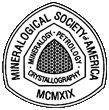 |
The Mineral Identification Key |  |
 |
The Mineral Identification Key |  |
Table IIC-2a: Nonmetallic Luster; Streak Not Colored; Hardness 2½ to 3; Cleavage Not Prominent; Splinter Will Fuse in a Candle Flame. [Previous Table] [Next Table]
| Fusibility | Color | Hardness | Luster | Name | System | Habit | SG | Notes |
| Swells and fuses to a glassy globule in a candle flame |
Usually Snow-white; Colorless to White or Greyish-white, may be tinted other colors | 2 to 2½ | Vitreous to resinous | BORAX |
Monoclinic | Usually in crystalline or granular masses, crystals
short prismatic to somewhat tabular, flattened prisms |
1.7 | Dissolves in water, has a sweetish, alkaline taste |
| Small splinters fusible in a candle flame | Colorless to White, may be tinted other colors | 2½ | Vitreous to greasy, has an unusual greasy translucence | CRYOLITE Na3AlF6 |
Monoclinic | Usually massively crystalline to coarse granular, crystal rare and usually pseudo-cubic |
2.95 to 3.0 | White streak; small clear fragments seem to disappear when placed in water (nearly identical refractive-index) |
| Small splinters fusible in a candle flame | Colorless to White or Greyish-White, may be tinted other colors | 3 to 3½ | Adamantine to vitreous, may be resinous on cleavage surfaces, may also appear submetallic when dark colored | CERUSSITE (Aragonite Group) PbCO3 |
Orthorhombic | Usually as crystalline to granular masses, crystals usually tabular in platy clusters or aggregates, may be prismatic, rarely acicular (habit widely varied) | 6.55 | Cleavage distinct in one direction and good in another, but rarely seen, effervesces in warm acid. Massive material difficult to distinguish from anglesite without testing for CO3 vs. SO4. Also see strontianite |
[ Table of Contents ] [ Introduction ] [ Identification Kit ] [ Mineral Properties ] [ Environments & Associations ] [ In Conclusion ] [ The Mineral ID Key ]
[Previous Table] [
Next Table]